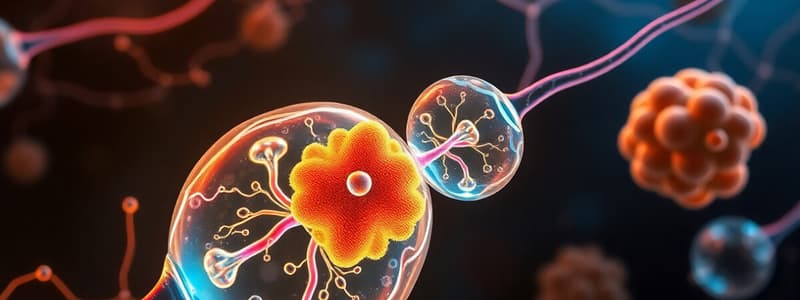Podcast
Questions and Answers
What is the primary function of enzymes in metabolic reactions?
What is the primary function of enzymes in metabolic reactions?
- To convert potential energy into kinetic energy
- To break down complex molecules only
- To provide energy in the form of ATP
- To catalyze reactions from reactants to products (correct)
Which of the following accurately describes catabolism?
Which of the following accurately describes catabolism?
- It is only involved in aerobic respiration.
- It produces potential energy exclusively.
- It requires energy to build complex molecules.
- It breaks down molecules and releases energy. (correct)
What is the primary outcome of the glycolysis process during cellular respiration?
What is the primary outcome of the glycolysis process during cellular respiration?
- It synthesizes complex molecules.
- It only occurs in the presence of oxygen.
- It generates oxygen molecules.
- It converts glucose into pyruvate and produces ATP. (correct)
What distinguishes oxidative phosphorylation from other steps in cellular respiration?
What distinguishes oxidative phosphorylation from other steps in cellular respiration?
What is the role of fermentation in energy production?
What is the role of fermentation in energy production?
What is the primary function of ATP in living cells?
What is the primary function of ATP in living cells?
What occurs during a redox reaction?
What occurs during a redox reaction?
Which molecule acts as an energy carrier in photosynthesis?
Which molecule acts as an energy carrier in photosynthesis?
Why can electrons not move independently in cells?
Why can electrons not move independently in cells?
Which best describes the source of energy for most living organisms on Earth?
Which best describes the source of energy for most living organisms on Earth?
Flashcards are hidden until you start studying
Study Notes
Metabolism and Energy
- Metabolism encompasses all chemical reactions in an organism, vital for sustaining life.
- Two metabolic pathways: catabolism (breaks down molecules, releasing energy) and anabolism (builds molecules, requiring energy).
- Energy is the capacity to perform work; forms include electrical, light, radiant, and heat.
Energy Carrier Molecules
- ATP (adenosine triphosphate) serves as the universal energy currency, storing energy in phosphate bonds.
- Other energy carriers include NADH and FADH2 in cellular respiration, and NADPH in photosynthesis.
Cellular Respiration Overview
- Cellular respiration consists of three main processes: glycolysis, citric acid cycle, and oxidative phosphorylation.
- Takes place in both aerobic (requires oxygen) and anaerobic (does not require oxygen) conditions.
Glycolysis
- Occurs in the cytoplasm, where glucose is split into two molecules of pyruvate.
- Generates a net output of 2 ATP and 2 NADH.
- Non-oxygen dependent process, laying the groundwork for further energy extraction.
Citric Acid Cycle
- Takes place in the mitochondria, using pyruvate to generate ATP and energy carriers.
- Produces 3 CO2, 1 ATP, 4 NADH, and 1 FADH2 per pyruvate.
- Fully oxidizes glucose (all 6 carbons) to CO2, recycling the starting molecules to continue the cycle.
Oxidative Phosphorylation
- Occurs in the inner mitochondrial membrane; uses the electron transport chain (ETC) to produce ATP.
- Approximately 34 ATP generated, making this the most productive step of respiration.
- Oxygen is the final electron acceptor, forming water.
Importance of Oxygen
- Critical for accepting electrons in oxidative phosphorylation, linking respiration to aerobic environments.
Fermentation
- A process allowing organisms to generate ATP without oxygen, mainly through glycolysis.
- Lactic acid fermentation occurs in muscles under hypoxic conditions, producing lactic acid which leads to fatigue.
- Alcoholic fermentation, seen in yeast, produces ethanol and CO2.
Enzymes in Metabolism
- Biological catalysts composed of amino acids, speeding up reactions without being consumed.
- Enzymes exhibit specificity, binding to specific substrates, essential for maintaining homeostasis.
Key Learning Points
- Understand enzyme roles in metabolic pathways.
- Recognize the distinction between oxidative phosphorylation and fermentation.
- Identify ATP yield from each stage of cellular respiration—total of approximately 38 ATP per glucose molecule.
Studying That Suits You
Use AI to generate personalized quizzes and flashcards to suit your learning preferences.




